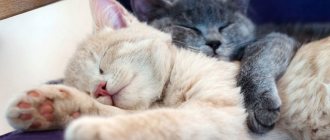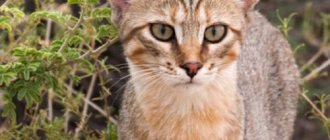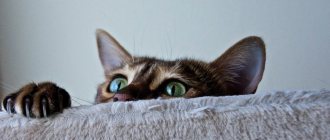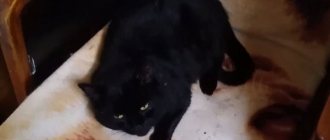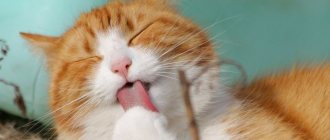Cats are the cutest and most affectionate pets! At the same time, these creatures are a complete mystery. In many cultures around the world, it is the cat that is the object of worship and veneration, since it is believed that these animals are connected with the other world. Here are 10 scientific facts about cats that will prove to you the uniqueness of fluffy purrs and, perhaps, help you better understand your tailed one.
Fact #8
A cat’s “whiskers” are not whiskers at all, but special tactile vibrissae hairs. They are located not only at the end of the muzzle, but also above the eyes and under the chin. And their analogues, smaller hairs that perform the same function, are also found on the animal’s body on the tail, on the inside and back of the limbs, on the pads of the paws, on the tips of the ears and in the ears themselves!
Vibrissae are a cat’s “space navigation system”; with their help, it orients itself in the world around it. It is a known fact that in cats with visual impairment these hairs are much longer and thicker than those in healthy animals - nature, as it were, compensates for the lack of one sense organ with the superiority of another.
Fact No. 7
If you think that your cat specifically waits until three or four o’clock in the morning to begin, vigorously stomping, rushing around the house, loudly visiting the litter box, or loudly inspecting all the shelves and cabinets, you are mistaken. She does not at all seek to disturb your sweetest morning dream.
The fact is that cats sleep about two-thirds of their lives - that is, 12-16 hours a day. Moreover, whether it’s day or night in the yard, it doesn’t really matter to them at home. They sleep in fits and starts - for several minutes or hours at a time, literally “as they want.” That’s why morning walks around the apartment are “just like that.”
Moreover, if the family is simply not at home during daylight hours, and the pet is alone, he will try to “kill for sleep” during the daytime in order to be less alone - and by the time you arrive he will already be cheerful and full of strength - rejoice , all evening and night ahead!
№4
A person has only 2 eyelids: upper and lower. Cats have three of them. The third eyelid is called the nictitating membrane. This is a thin light film in the corner of the eye. It plays an important role in protecting the eyes. It removes debris and distributes moisture evenly throughout the eye so it doesn't dry out.
Also, the third eyelid protects their eyes from tall grass or when hunting.
Fact #3
A cat's meow is not “conversation” at all. In addition to body language and gaze, cats communicate with their fellow cats using a number of other sounds - purring, rumbling, grumbling, squeaking, snorting, howling, hissing and even whistling and “chirping”. Moreover, cats pronounce each of these sounds with dozens of intonations (dogs, for example, have an order of magnitude fewer of these), giving them, accordingly, a different meaning.
Adult cats use a short, loud and sonorous “meow” with a rising (“questioning”) intonation only when they are in pain and when addressing kittens, when they are trying to attract their attention. Well, with a person, for the same purpose - they say, “what do you need,” or “look at me and do this and that!”
Why do cats knock everything over?
Definitely not because of clumsiness. If your cat drops a cup of coffee on your keyboard, it may be sick or nervous, or wants to draw your attention to an issue that is important to it. Cats are very nervous creatures; anything can throw them out of balance. The only way out is to provide your pet with more living space. The possibility of privacy has a calming effect on furry brats.
Photo: Andreas Lischka / Pixabay
Fact #4
The movement when a satisfied and peaceful cat kneads your side or just a soft blanket with its front paws, extending and retracting its claws, has a completely scientific name - “milk step”. This term arose due to the fact that the animal imitates its infant behavior in this way - it is with this movement that kittens stimulate the release of milk from the mother’s nipples when feeding. In adulthood, the “milk step” indicates that your pet currently feels extremely satisfied and protected.
Fact #9
If you think that absolutely all cats “go crazy” from valerian, you are mistaken - some animals completely ignore its smell, while others find it very unpleasant. And for good reason, by the way - consuming the root of the valerian plant (“cat grass”), from which the medicine is produced, can cause real poisoning in your pet.
But still, the majority of domestic animals and their large wild relatives actually react to this drug very violently, sometimes even aggressively. And all because the source plant contains the substance actinidin, the smell of which is almost similar to one of the components of pheromones contained in cat urine, as a result of which the stimulating effect of valerian changes the hormonal and emotional background of the animal.
In a similar way, but due to a different component, nepetalactone, catnip extract (“catnip”) also acts on representatives of the cat family.
Where do cats get their white socks?
When a kitten is formed in the womb, the pigment that gives color to the fur appears first in the area of the spine, from where it is subsequently distributed in all directions throughout the body. If the pigment is not completely distributed by the time of birth, the kitten's paws and belly will remain white. This is where cats get white “socks” on their paws.
Photo: Doris Metternich / Pixabay
Why do cats drink water from anywhere other than their own bowl?
Because they are afraid of getting poisoned. For millions of years, a cat's food in the wild was animals killed by it or someone else. The cat could not know how long the carcass she found had been lying there, and whether the microbes that had bred in it had ended up in the nearest body of water. Even if the animal itself had just killed the victim, fresh blood did not improve the taste of the water. Therefore, predators do not drink water in the same place where they dine.
Photo: Nadine Doerlé/Pixabay
All cats sweat
Yes, cute furries can sweat too. But they do this not like humans, but only in small areas of their body - pads on their paws, small areas on the cheeks and lips, and also around the nipples. Although Sphynx cats should also be mentioned here. They are the only cats that can not only sweat all over their bodies, like humans, but also leave dark stains on light-colored things from sweat. A sweaty Sphynx becomes covered with a coating that can be confused with a tan.
Fact #6
Surely any cat owner has encountered a situation where the pet insistently demands to open all the doors in the apartment or house. Moreover, this does not mean at all that he wants to enter there.
In most cases, the fluffy is completely satisfied with the very fact of opening, without even bothering to glance at the seemingly treasured next room.
It's all about the predatory nature of cats. They don’t need the next room at all, and they demand to open the door to it in order to completely control their own territory (yes, if you don’t already know, your apartment belongs to your cat, and certainly not to you). Behind a closed door all sorts of dangers and unknowns can lurk, and with its opening there is an excellent opportunity to look in there (if you suddenly want to), find out everything, or even escape.
Cats love to kill
Scientists have proven that only in 28% of successful hunts do cats eat their prey. The rest of the murders are committed not from hunger, but for the sake of pleasure. Sometimes the prey serves as a trophy, which is proudly presented to the owner. For example, Jungle cats are born hunters. They even catch fish for their own pleasure, completely immersing themselves under water. Their hunting instincts are so strong that having chosen a victim, they can wait for hours for the right moment to attack.
Fact #5
If your cat regularly brings you prey (and it can be killed birds and mice, as well as strange objects like large flowers or mittens), and you are only touched, you are doing the right thing.
Firstly, this means that your animal is healthy and active, and has not lost its hunting instinct. Secondly, this means that the pet... uh... not that it really loves you very much, but at least pities you - you are so stupid, unable to hunt on your own.
- Cat at the dacha: how to prepare the area for the arrival of your pet
In the summer, many summer residents transport their pets to suburban areas. How to make sure that the cat doesn’t get into trouble and the dacha doesn’t get damaged?
The fact is that in nature, adults instinctively bring killed or strangled prey only to the cubs (so that they slowly learn hunting skills) or to sick fellow tribesmen. Choose who you are more like in your cat's eyes.
Fact #2
In absolute darkness, a cat, contrary to popular belief, cannot see.
Yes, these pets have excellent eyesight - they are nocturnal predators by nature. Therefore, in low light conditions, they still see much better than a person thanks to the greatly increased number of rod photoreceptors in the eye and a special reflective layer, the tapetum. As a result, at dusk, a cat’s vision is 7 times sharper than ours.
It is interesting that in normal and bright light, on the contrary, a person’s vision will give a head start to a cat’s, especially if it concerns stationary objects that cats do not perceive as well as moving ones.
Also, unlike humans, cats have a slightly larger viewing angle (200° instead of 180°), but they perceive color differences much weaker and have difficulty refocusing from close to distant objects and back.
№11
How long a domestic cat will live is influenced by the conditions in which it lives. For example, cats that live exclusively in houses or apartments, with no access to the outdoors, typically live about 12-20 years. Cats that live indoors and outdoors or exclusively outdoors, on average, do not live longer than 3-10 years.
Can be very jealous
This statement especially applies to the Siamese cat breed. They are very distrustful of strangers and can begin to behave unpredictably if they decide that you are devoting too little time to them. You should also not have other animals. Characteristic cats can turn out to be real warriors and repel a competitor on their territory. If a child appears in the family, acquaintance with the animal should take place gradually and under the supervision of adults.

